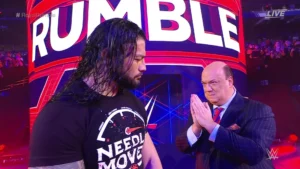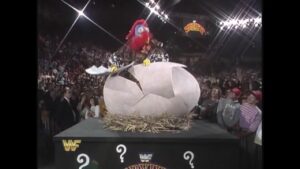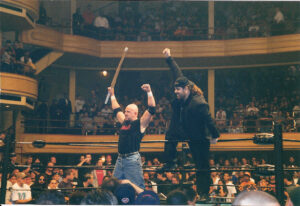Brock Lesnar is a phenomenon. The man nicknamed “the Beast Incarnate” has lived up to the billing over the past two decades. Though he appears to be done with WWE and pro wrestling for the foreseeable future, he remains one of the hottest acts in the business. Over the course of this two-part series, we are going to take a look at the career of the Beast. It is a career of two halves; one of freakishly gifted, young rookie and one of internationally recognized MMA titan boxed into a wrestling ring. Therefore, Part 1 will take a look at the initial Brock WWE run. Part 2, coming next week, will take a look at Lesnar’s WWE career since his 2012 return. Let us begin by taking a look at Lesnar’s time in Ohio Valley Wrestling.
Brock Lesnar Joins OVW (2000)
“He liked hauling things, he liked being the supervisor. It taught him responsibility. There’s more to this stuff than just showing up and doing an F5. Everybody there had a job. Our ring crew was bad ass.” – Jim Ross (h/t Wrestling INC)
When Brock Lesnar walks into a room, he immediately draws eyes. Standing around six-feet-four, weighing an incredible 280lbs of pure muscle, Brock is an eye-drawing freak of nature. For Brock Lesnar to still have this impression in the world of professional wrestling perfectly displays just how different he is. For Brock to walk into Ohio Valley Wrestling in 2000 and still appear so different speaks volumes. OVW at that time had such talent as a young John Cena, Batista and Randy Orton. Yet immediately, Brock stood out as the guy. It helped, of course, that Brock was fresh off the heels of a hugely successful NCAA triumph in 2000.

He was scouted at the event and boasting an amateur record of 106-5, he was always destined for greatness. However, though possessing immeasurable potential and a look unlike any other, it was quickly noted that Brock was no fan of pro wrestling. Jim Cornette, then head booker and part-owner of OVW, summed Brock up best.
“Brock is a behemoth with a lot of natural, athletic skill, but very little passion for the wrestling business itself.” – Jim Cornette
The behemoth-like qualities, coupled with the “natural, athletic skill” would, of course, be enough to carry Brock to the big time. Though Brock is notoriously antisocial, he did become close friends with Shelton Benjamin. The two men, friends dating back to their college days, would become godfathers of each other’s children. They would become an OVW tag team, though the team would never see the light of the main roster. Paul Heyman, an early fan of Lesnar, would take him under his wing, thus ending the tag team. By 2002, it was time for Lesnar to make the leap to the WWE main roster.
“The Next Big Thing” (2002)
Brock Lesnar, accompanied by Paul Heyman, debuted on RAW on March 18, 2002. He destroyed Al Snow, Maven and most notably Spike Dudley during an impressive display of his general freakishness. That was the point, after all. In 2002, WWE (as it had recently become) was in a transition phase. Stone Cold Steve Austin was a year away from retirement and The Rock was flirting with Hollywood. Vince McMahon‘s old guard, who secured the WWF a successful victory over WCW during the Attitude Era, was finally faltering.

There was an opening for the next big thing to lead the WWE through the 2000s. Of course, Brock would soon become known as “The Next Big Thing”, the precursor to “The Beast”. In a short, four month spell on RAW, Brock would dominate. He would become the 2002 King of the Ring, defeating Rob Van Dam in the final. A DQ loss to RVD at Vengeance would follow, before a successful move to SmackDown. On SmackDown, Brock would become established as “the Next Big Thing”.
Here Comes the Pain: Brock Lesnar Moves to SmackDown
Being a freakishly sized killing machine, Brock drew comparisons to Rocky IV villain, Ivan Drago. Like Drago, Brock did not talk much – instead relying on managers. Paul Heyman, as the advocate of Lesnar, would form the vocal half of arguably the greatest wrestler/manager combination in history. On SmackDown, the two of them would really begin hitting the ground running with this partnership. When you think of Brock Lesnar’s first WWE run, you think of SmackDown. You think of Taz on commentary, shouting “here comes the pain!” when Brock’s music hits. You think of the WWE Undisputed Championship, Lesnar’s very first being captured from The Rock at SummerSlam 2002. Indeed, Lesnar’s first world championship was captured from “The Great One” in a passing of the torch moment. Lesnar became the youngest WWE champion in history (25) with the win – a record that still stands today.
The WWE Undisputed Championship would soon become the WWE Championship. Originally intended to be a cross-brand championship, the WCW Championship title affectionately dubbed “Big Gold” would instead be re-branded as the World Heavyweight Championship for SmackDown. Lesnar was now exclusive to SmackDown. The former face of the brand, The Rock, would turn heel immediately after his SummerSlam 2002 defeat and go to film movie Walking Tall before returning to RAW in early 2003.
The WWE Champion

Brock would soon establish the WWE Championship as WWE’s number one. As the arguable face of the blue brand (and the company), SmackDown entered something of a golden era. Such talent as Eddie Guerrero, Edge, Rey Mysterio, Undertaker, Kurt Angle and John Cena made SmackDown WWE’s number one wrestling show. During a time when Triple H‘s “Reign of Terror” was in full swing on RAW, it provided a much-needed dose of common sense. Brock would feud with all of the names listed, first with Undertaker. Undertaker will go down as one of Lesnar’s greatest rivals, if not the greatest. Lesnar would be victorious over “Big Evil” in a series of matches, culminating in a Hell in a Cell victory at No Mercy 2002. Following this came a feud between Brock Lesnar and Big Show. This would, of course, lead to a rare sight: a Lesnar face turn.
Brock Lesnar: The Unlikely Babyface
At Survivor Series 2002, Paul Heyman turned on Brock Lesnar; allowing Big Show to hand Brock his first pinfall defeat. A premature end to a duo that worked, but McMahon clearly saw Brock as the next face of the company. Therefore, he needed to be a babyface. This would lead to Brock becoming marketed as the face of the company. He would lead commercials; would do media interviews (much to his chalice) and was on the face of WWE’s hugely successful SmackDown: Here Comes the Pain video game. The preceding game was SmackDown: Shut Your Mouth, which featured The Rock on the cover. The “passing of the torch” moment at SummerSlam 2002 was just that. The Ruthless Aggression era was in full-swing and Brock Lesnar was spearheading it. At Armageddon 2002, Lesnar interfered in Big Show’s title defense against Kurt Angle, costing Show the match.
In a freakish display of strength, Lesnar gave an F-5 to the then-legitimately 500lbs Big Show. The feud would culminate at Royal Rumble 2003, with the winner entering the Royal Rumble match later in the night. Lesnar would defeat Big Show and then win the Royal Rumble match, entering at number 29. So in less than a year since his debut: Brock won the King of the Ring, became the youngest WWE Champion in history and won the Royal Rumble. There is a reason it is considered the most successful debut year in wrestling history. Lesnar would go on to defeat Kurt Angle and reclaim his WWE Championship at WrestleMania XIX, though not without a concussion from a botched shooting star press. Regardless, the Next Big Thing was officially commiserated as the Current Big Thing.
Return to Being a Heel
Brock Lesnar would lose the championship back to Angle at Vengeance 2003, in a triple threat match including Big Show. Despite the loss, Lesnar would go on to form an unlikely friendship with Kurt Angle in 2003. The two would compete in a number of hilarious backstage skits, which really showcased both men’s personality. With Lesnar an NCAA Champion and Angle an Olympic Gold Medalist, it is perhaps not surprising that they would be so competitively friendly. However, it soon turned out to be a Machiavellian scheme by Lesnar to reclaim his lost WWE Championship. The heel turn would come on an episode of SmackDown, during a match with Vince McMahon (with Angle as special guest referee). After Brock feigned unconsciousness, he and McMahon turned on Angle and gave him a brutal beat down. Brock was officially a bad guy once more.
Brock would then lose once more to Angle at SummerSlam 2003. In failing to recapture the gold, he would go on a warpath – taking out smaller wrestlers. Perhaps most notably, he pushed Zach Gowan down a flight of stairs in a wheelchair. This would eventually draw Angle out once more. Brock would finally defeat him in an Iron Man match on SmackDown (September 18th 2003). Lesnar would hold the title until the following February, when he would now-famously lose it to Eddie Guerrero at No Way Out 2004. The victory is one of the first instances of a wrestler considered “too small” claiming the main title from the company’s face. Therefore, it is considered a monumental moment in WWE history.
Feud With Goldberg and Departure From the WWE
Brock Lesnar, in the aftermath of the loss to Guerrero, would return to RAW. He was already in a long-standing feud with Goldberg and was now ready to put an end to the former WCW titan. Stone Cold Steve Austin, who was originally scheduled to lose to Lesnar at SummerSlam 2002, became embroiled in the feud. Austin, who had become relatively friendly with Goldberg, suggested he attack Lesnar at No Way Out, to send a message. This led to Lesnar resenting the Texas Rattlesnake and eventually attacking him on RAW. This would lead to the infamous match between the two at WrestleMania XX. The news broke weeks in advance that Goldberg was leaving the company. To make matters even worse, a week before the show, it was revealed Lesnar was leaving to pursue a career in the NFL. Goldberg would win the WrestleMania match which became infamous for both men getting booed out of the building. To make the crowd happy, both men received a Stunner from Austin. Brock Lesnar, the “Next Big Thing”, was now out the door – his spot as “face of the company” going to John Cena, who would carry the mantle for over a decade.
The Legacy of the First Run
Brock Lesnar, during his first run, was a completely different performer to the one that returned in 2012. Indeed, he was a freakish wrestler; combining ridiculous feats of strength with sublime amateur wrestling; with a sprinkle of the extraordinary added for good measure. This combined with his general look and presence made him arguably the most naturally gifted performer in WWE history. Despite this, Lesnar – as aforementioned by Cornette – had next-to-no passion for the wrestling business. He would go onto a failed attempt at NFL fame, before a polarizing run in New Japan Pro Wrestling. Ultimately, he would end up in the UFC – where he would become UFC Heavyweight Champion before a bout of diverticulitis brought that venture to a close. What came next? Well, you will have to read part 2 next week. The period of “the Next Big Thing” was a certified phenomenon, but what came later is far more debatable.
Stay tuned to Last Word on Pro Wrestling for more on this and other stories from around the world of wrestling, as they develop. You can always count on LWOPW to be on top of the major news in the wrestling world, as well as to provide you with analysis, previews, videos, interviews, and editorials on the wrestling world. WWE and Brock Lesnar fan? You can check out Brock’s sit-down podcast with “Stone Cold” Steve Austin, as well as all of your favorite matches on the WWE Network.






